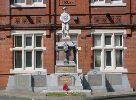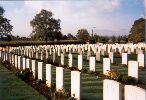
Newton-le-Willows and
Earlestown War Memorial

| OTHER WARS |
 |
Newton-le-Willows andEarlestown War Memorial |
 |
| The
Great War Roll of Honour |
|||||||||||||||||||||||||

Private Tracey was born in London according to the NEG, though SDGW gives his place of birth as Chorley, Lancashire, and moved to Earlestown in 1907 from Horwich, near Bolton. He was employed in the forge at the Vulcan and joined the 2nd South Lancashires at Preston, at the outbreak of war. (The memorial at Emmanual Church gives his regiment at 2nd Lancashire Fusiliers.) He was a single man, and had previous service in the Army, and fought through the South African (Boer) War.
He was wounded on the 11th April in France and died from his injuries at North London or University College Hospital, Gower Street, London. The Newton and Earlestown Guardian obituary published on May 21st 1915 gives his age as 35, though CWGC gives it as 40. At the outbreak of war, he was living at either 3 or 8, Liverpool Row, Vulcan, with Mrs. Houghton who received a letter from Sister B. Stevens of Ward 6 of the hospital:
“I regret to have to tell you that Private Tracey passed peacefully away quite suddenly last night at a late hour. It was really the best thing for him, for if he had lived he very probably would not have been able to look after himself.”
Private Tracey is buried in Kensal Green (All Souls’) Cemetery, London, in grave 213.5.I (Screen Wall), a cemetery which contains 475 First World War graves.
There was no specific battle on the date when Private Tracey was wounded, but the battalion was spending a lot of time in the front line. In “Ich Dien”, Whalley-Kelly gives a flavour of life with the 2nd Battalion in the early part of 1915:
“During the first few months of 1915 the trenches occupied were situated on the lower slopes of the Messines Ridge in the neighbourhood, at different periods, of Lindenhoek, Kemmel, Spanbrockmolen, Wytschaete and St. Eloi, names that will live for ever in the memory of those who fought for England in 1914-1918. The word "trenches" is used, but it is a misnomer, conveying quite a wrong impression of the actual facts. In the inferno of the First Ypres both sides had fought to a standstill and the British troops had "dug in" wherever they happened to be when the last embers of the battle were flickering and dying out, and this was not always the best position for a prolonged defence or sojourn, either tactically or topographically. Consequently the front line consisted mainly of disconnected lengths of muddy field works, partly trench, partly breastwork, with few traverses and little shelter from the elements or the enemy's shells. Duckboards, communication trenches, deep dug-outs and other refinements of later days were non-existent, and the exposed position of many of the localities made improvement a matter of great danger and difficulty.
“At this period the normal tour for companies in the front
line was twenty-four hours, during which a hot meal was a rare luxury, and
there was no possibility of drying clothes, sodden with mud and water, after
a journey, crouching and crawling, across the open to carry out the relief.
The dead of both sides had been built into the parapets and parados, and it
was no uncommon thing to find an arm or a leg projecting from the revetment;
while in one isolated trench, held by the 2nd Battalion at various times,
it is no exaggeration that the platoon officer's command post consisted of
sandbags supported by a dead Frenchman covered with a few inches of earth.
With this grisly seat the occupant had to be content, and counted himself
lucky to be raised above the mud, while his feet rested on something hidden
in the slime - a "something" which was later discovered to be the
rotting corpse of a Prussian grenadier.”